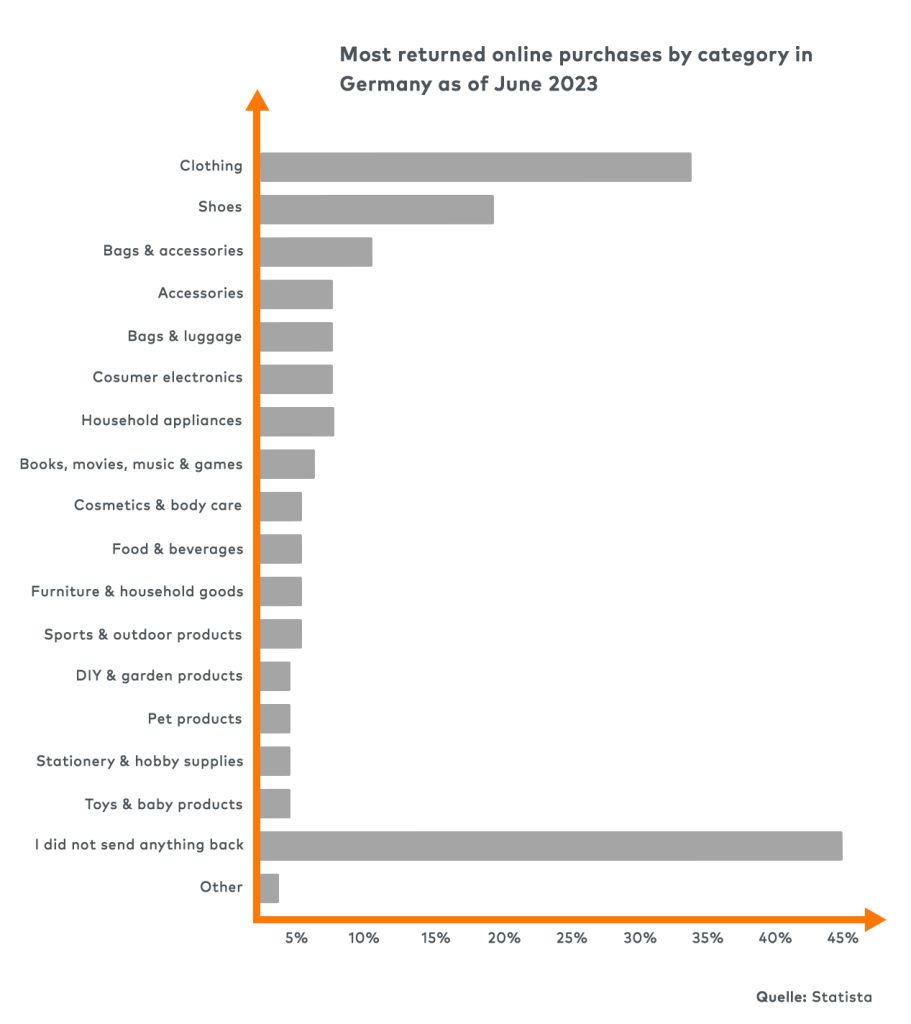High return rates are now the new norm in e-commerce, with far-reaching consequences for companies. On average, every fourth parcel in Germany is returned. This could be due to the fact that no other EU country has so many free returns and online retailers generally offer generous return periods.
The return rate has also increased in the USA. In 2021, returns accounted for an average of 16.6% of all retail sales in the US. In the previous year, this figure was 10.6%.
This not only has an impact on online retailers, but also on the environment. According to the National Retail Federation, the average retailer incurs approximately $166 million in return costs for every $1 billion in sales. The Bamberg research group found that around 795,000 tons of CO2 were caused by returns in 2021.
Customers are not a fan of returns
It is important to understand that returns are also usually a negative experience for customers. Even if they offer the possibility of returning unsuitable or faulty products, they are often difficult and time-consuming. In addition, long processing times for returns can lead to delays in refunds.
This raises the question of why a return is necessary. Was it due to an inaccurate product description or even incorrect information? Or was the product damaged due to faulty packaging? In the worst case, such reasons can shake trust in the online store and drive customers to the competition.
Companies should make every effort to reduce their return rate in the long term. This not only helps to keep additional costs to a minimum, but also increases customer satisfaction and ensures competitiveness.
Before we move on to the possible solutions, let’s take a look at the main reasons for customer returns.
Product-related reasons
Wrong size or fit
The classic reason. Especially with clothing and shoes, the sizes ordered often simply don’t fit.
Color deviations
The color looks different in reality than it was shown in the online store.
Poor quality
The product is poorly made and customers are not satisfied with it.
Wrong product
Customers are in for a nasty surprise when they open a parcel and find a different product than they ordered.
Damaged goods
Broken, defective or dented – time and again, products do not survive transportation undamaged.
In the fashion sector in particular, the wrong size or fit is a typical reason for returning goods. A survey by Statista on the most frequently returned products also shows that this sector has the highest return rate.
Customer decisions that lead to returns
Change of opinion
Spontaneous purchases are not uncommon, and customers can change their minds after making a purchase.
Price comparison
A customer might find the product cheaper elsewhere after buying it and then return the more expensive version.
Duplicate purchases
It happens more often than you might think: customers accidentally order the same product several times, even though they only need one.
Gifts
Not every gift meets the taste, and some end up back at the retailer.
Does not meet expectations
The product often does not meet the customer’s expectations, for example due to misleading product descriptions or images.
Test purchases
Some customers order several variants of a product in order to compare them. Then they send back the unwanted products.
Delayed delivery
If the customer receives the product too late and no longer needs it, it is likely to be returned.
5 approaches for minimizing returns
1. optimize your product descriptions
Improving your product descriptions not only reduces the return rate in your online store, but also increases customer confidence. Clarity and attention to detail are crucial to ensure that your customers get exactly what they are looking for.
Your product description should contain all essential information, from technical features and materials to the origin of the product. Be particularly precise with color nuances, as images may not reflect the actual color depending on the screen settings and device used.
For clothing in particular, it is important to provide a size chart or detailed information on the fit. This allows customers to find out in advance whether the item is available in the desired size, reducing the likelihood of returns due to sizing issues. Feedback from other customers who have already ordered can also be useful.
2. offer detailed product information with photos and videos
By providing your customers with comprehensive product information, you can significantly reduce the return rate in your online store. High-resolution images and appealing videos play a central role here. Thanks to close-ups and a practical zoom function, your customers can almost physically immerse themselves in the world of your products.
For more complex products, you can go one step further: Explainer videos illustrate all the special features and functions so that your customers can see exactly whether the product meets their requirements.
3. customer and product reviews are essential
Customer and product reviews are an effective way to reduce the return rate in your online store. Such reviews provide potential customers with valuable insights into the products they wish to purchase. This is because they often contain information, perspectives and experiences that are rarely found in a product description.
Customers often provide answers to questions that retailers may not even have thought of. Only customer reviews allow potential buyers to see how satisfied other customers were with a particular product and whether it met their expectations.
4. provide first-class and personalized customer service
Good customer service is crucial if online retailers want to minimize their return rates. This is because satisfied customers who benefit from outstanding customer service are less likely to return their purchases. One example here could be chat support that advises customers in real time while they are selecting products.
Another important aspect is to make returns uncomplicated and smooth. Clear instructions and a well-structured returns process make it easier for your customers to handle returns. This makes them feel well looked after.
In addition, individual advice and an open dialog with customers can further reduce the likelihood of returns.
5. optimize your shipping and delivery conditions
Efficient and reliable shipping is crucial to increase customer satisfaction and minimize the number of returns due to delays. Fast delivery can make all the difference as customers expect their orders to arrive within a reasonable time frame. Longer delivery times can lead to dissatisfaction, especially with items for special occasions such as Christmas, birthdays or celebrations. Not to mention the increased likelihood of returns if products arrive too late and are no longer needed.
Another effective approach to improving the shipping process is to use robust and high-quality packaging. This protects the goods from transport damage and reduces the likelihood of returns.
A combination of speedy delivery and better quality packaging will not only help to increase customer satisfaction, but will also make your shipping and delivery process much more efficient, which will also reduce returns.
Summary
Ultimately, it is of the utmost importance for online stores to constantly evolve and focus on the needs of their customers. The strategies presented provide a sound basis for reducing return rates and optimizing customer service at the same time.
It’s not just about saving costs, but above all about building a loyal customer base that has confidence in your store and is happy to return. So focus on quality, transparency and an open dialog. Investment in these areas pays off in the long term in the form of satisfied customers, a positive brand image and ultimately in rising sales.
The 5 biggest challenges in online payment for e-commerce merchants!
An informative guide for anyone seeking a deeper understanding of modern payment transactions and their requirements.



